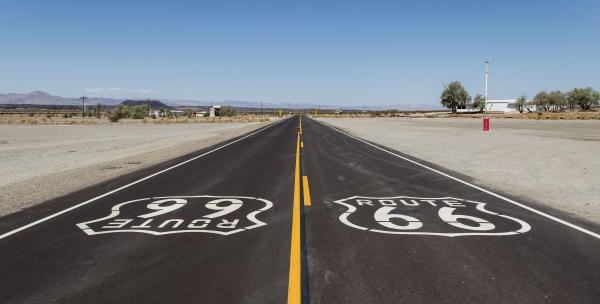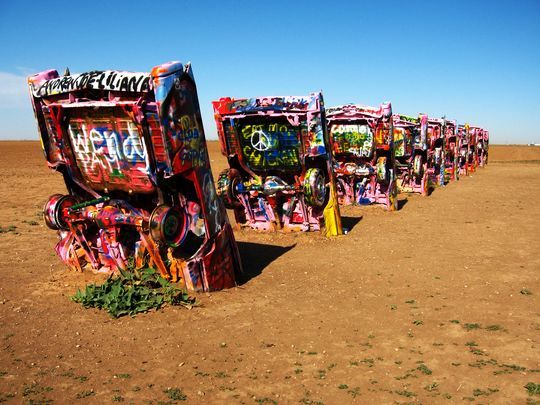Route 66 History:
U.S. Route 66 (US 66 or Route 66), also known as the Will Rogers Highway, the Main Street of America or the Mother Road, was one of the original highways within the U.S. Highway System. US 66 was established on November 11, 1926, with road signs erected the following year. The highway, which became one of the most famous roads in the United States, originally ran from Chicago, Illinois, through Missouri, Kansas, Oklahoma, Texas, New Mexico, and Arizona before ending at Santa Monica, California, covering a total of 2,448 miles (3,940 km). It was recognised in popular culture by both the hit song "(Get Your Kicks on) Route 66" and the Route 66 television show in the 1960s.
US 66 served as a major path for those who migrated west, especially during the Dust Bowl of the 1930s, and the road supported the economies of the communities through which it passed. People doing business along the route became prosperous due to the growing popularity of the highway, and those same people later fought to keep the highway alive in the face of the growing threat of being bypassed by the new Interstate Highway System.
US 66 underwent many improvements and realignments over its lifetime, and it was officially removed from the United States Highway System in 1985, after it had been replaced in its entirety by segments of the Interstate Highway System. Portions of the road that passed through Illinois, Missouri, New Mexico, and Arizona have been designated a National Scenic Byway of the name "Historic Route 66", which is returning to some maps. Several states have adopted significant bypassed sections of the former US 66 into the state road network as State Route 66.
 Before the U.S. Highway System
Before the U.S. Highway System
A remnant of an original state right-of-way marker serves as a reminder of the early days of the road's construction. This was part of the 1927 construction of US 66.
In 1857, Lt. Edward Fitzgerald Beale, a Naval officer in the service of the U.S. Army Corps of Topographical Engineers, was ordered by the War Department to build a government-funded wagon road along the 35th Parallel. His secondary orders were to test the feasibility of the use of camels as pack animals in the southwestern desert. This road became part of US 66.
Parts of the original Route 66 from 1913, prior to its official naming and commissioning, can still be seen north of the Cajon Pass. The paved road becomes a dirt road, south of Cajon, which was also the original Route 66.
Before a nationwide network of numbered highways was adopted by the states, named auto trails were marked by private organizations. The route that would become US 66 was covered by three highways. The Lone Star Route passed through St. Louis on its way from Chicago to Cameron, Louisiana, though US 66 would take a shorter route through Bloomington rather than Peoria. The transcontinental National Old Trails Road led via St. Louis to Los Angeles, but was not followed until New Mexico; instead US 66 used one of the main routes of the Ozark Trails system, which ended at the National Old Trails Road just south of Las Vegas, New Mexico. Again, a shorter route was taken, here following the Postal Highway between Oklahoma City and Amarillo. Finally, the National Old Trails Road became the rest of the route to Los Angeles.
While legislation for public highways first appeared in 1916, with revisions in 1921, it was not until Congress enacted an even more comprehensive version of the act in 1925 that the government executed its plan for national highway construction. The original inspiration for a roadway between Chicago and Los Angeles was planned by entrepreneurs Cyrus Avery of Tulsa, Oklahoma, and John Woodruff of Springfield, Missouri. The pair lobbied the American Association of State Highway Officials (AASHO) for the creation of a route following the 1925 plans.
From the outset, public road planners intended US 66 to connect the main streets of rural and urban communities along its course for the most practical of reasons: most small towns had no prior access to a major national thoroughfare.
Birthplace and rise of US 66

The numerical designation 66 was assigned to the Chicago-to-Los Angeles route on April 30, 1926, in Springfield, Missouri. A placard in Park Central Square was dedicated to the city by the Route 66 Association of Missouri, and traces of the "Mother Road" are still visible in downtown Springfield along Kearney Street, Glenstone Avenue, College, and St. Louis streets and on Route 266 to Halltown, Missouri.
Championed by Avery when the first talks about a national highway system began, US 66 was first signed into law in 1927 as one of the original U.S. Highways, although it was not completely paved until 1938. Avery was adamant that the highway have a round number and had proposed number 60 to identify it. A controversy erupted over the number 60, largely from delegates from Kentucky who wanted a Virginia Beach–Los Angeles highway to be US 60 and US 62 between Chicago and Springfield, Missouri.
Arguments and counterarguments continued throughout February, including a proposal to split the proposed route through Kentucky into Route 60 North (to Chicago) and Route 60 South (to Newport News). The final conclusion was to have US 60 run between Virginia Beach, Virginia, and Springfield, Missouri, and the Chicago–L.A. route be US 62. Avery and highway engineer John Page settled on "66," which was unassigned, because he thought the double-digit number would be easy to remember as well as pleasant to say and hear. Both Avery and Page also appreciated
the number 66's use in numerology as a master number bringing material pleasure and success.
The state of Missouri released its 1926 state highway map with the highway labeled as US 60.
After the new federal highway system was officially created, Cyrus Avery called for the establishment of the U.S. Highway 66 Association to promote the complete paving of the highway from end to end and to promote travel down the highway. In 1927, in Tulsa, the association was officially established with John T. Woodruff of Springfield, Missouri, elected the first president. In 1928, the association made its first attempt at publicity, the "Bunion Derby," a footrace from Los Angeles to New York City, of which the path from Los Angeles to Chicago would be on US 66. The publicity worked: several dignitaries, including Will Rogers, greeted the runners at certain points on the route. The race ended in Madison Square Garden, where the $25,000 first prize (equal to $356,298 in 2017) was awarded to Andy Hartley Payne, a Cherokee runner from Oklahoma. The U.S. Highway 66 Association also placed its first advertisement in the July 16, 1932, issue of the Saturday Evening Post. The ad invited Americans to take US 66 to the 1932 Summer Olympics in Los Angeles. A U.S. Highway 66 Association office in Oklahoma received hundreds of requests for information after the ad was published. The association went on to serve as a voice for businesses along the highway until it disbanded in 1976.
Traffic grew on the highway because of the geography through which it passed. Much of the highway was essentially flat and this made the highway a popular truck route. The Dust Bowl of the 1930s saw many farming families, mainly from Oklahoma, Arkansas, Kansas, and Texas, heading west for agricultural jobs in California. US 66 became the main road of travel for these people, often derogatorily called "Okies" or "Arkies." During the Depression, it gave some relief to communities located on the highway. The route passed through numerous small towns and, with the growing traffic on the highway, helped create the rise of mom-and-pop businesses, such as service stations, restaurants, and motor courts, all readily accessible to passing motorists.
The Chain of Rocks Bridge across the Mississippi River was built to carry the growing traffic of US 66 around the city of St. Louis.

Much of the early highway, like all the other early highways, was gravel or graded dirt. Due to the efforts of the U.S. Highway 66 Association, US 66 became the first highway to be completely paved in 1938. Several places were dangerous: more than one part of the highway was nicknamed "Bloody 66" and gradually work was done to realign these segments to remove dangerous curves. However, one section through the Black Mountains outside Oatman, Arizona, was fraught with hairpin turns and was the steepest along the entire route, so much so that some early travelers, too frightened at the prospect of driving such a potentially dangerous road, hired locals to navigate the winding grade. The section remained as US 66 until 1953 and is still open to traffic today as the Oatman Highway. Despite such hazards in some areas, US 66 continued to be a popular route.
Notable buildings include the art deco–styled U-Drop Inn, constructed in 1936 in Shamrock, in Wheeler County east of Amarillo, Texas, listed on the National Register of Historic Places. A restored Magnolia fuel station is also located in Shamrock as well as Vega, in Oldham County, west of Amarillo.
During World War II, more migration west occurred because of war-related industries in California. US 66, already popular and fully paved, became one of the main routes and also served for moving military equipment. Fort Leonard Wood in Missouri was located near the highway, which was locally upgraded quickly to a divided highway to help with military traffic.
When Richard Feynman was working on the Manhattan Project at Los Alamos, he used to travel nearly 100 miles (160 km) to visit his wife, who was dying of tuberculosis, in a sanatorium located on US 66 in Albuquerque.
In the 1950s, US 66 became the main highway for vacationers heading to Los Angeles. The road passed through the Painted Desert and near the Grand Canyon. Meteor Crater in Arizona was another popular stop. This sharp increase in tourism in turn gave rise to a burgeoning trade in all manner of roadside attractions, including teepee-shaped motels, frozen custard stands, Indian curio shops, and reptile farms. Meramec Caverns near St. Louis, began advertising on barns, billing itself as the "Jesse James hideout." The Big Texan advertised a free 72-ounce (2.0 kg) steak dinner to anyone who could consume the entire meal in one hour. It also marked the birth of the fast-food industry: Red's Giant Hamburg in Springfield, Missouri, site of the first drive-through restaurant, and the first McDonald's in San Bernardino, California. Changes like these to the landscape further cemented 66's reputation as a near-perfect microcosm of the culture of America, now linked by the automobile.
